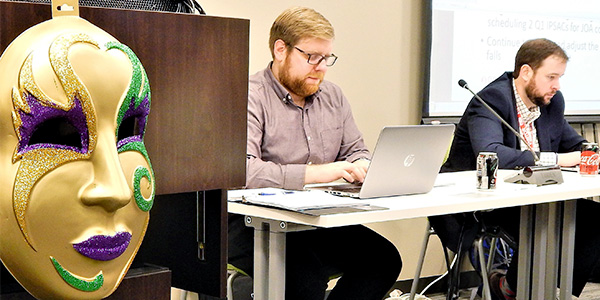By Tom Kleckner
METAIRIE, La. — MISO and SPP staff told stakeholders last week that there is “more support than not” for the RTOs to conduct a joint study of interregional transmission projects in 2019, and each year after that.
The RTOs’ interregional groups spent much of 2018 revising their joint operating agreement to increase the odds of agreeing on interregional projects. By improving the joint study — or coordinated system plan (CSP) — and its efficiency and effectiveness, the RTOs hope to identify and build “cost-effective projects that provide benefits to both regions.” (See MISO, SPP Tweak Interregional Criteria.)
The staffs eliminated a $5 million cost threshold for the projects, added avoided costs and adjusted production cost benefits to project evaluation, mandated CSP studies, and removed the joint modeling requirement in favor of individual RTO regional analyses done simultaneously.
MISO Expansion Planning Engineer Ben Stearney said during a Jan. 31 Interregional Planning Stakeholder Advisory Committee (IPSAC) meeting that staff expect the joint study to be done annually. The committee later this month will help determine whether that process begins this year.
“This will allow us to prepare a better analysis or comparison of regional projects, because they’re done simultaneously,” Stearney said.
MISO and SPP conducted CSP and regional reviews in 2014 and 2016 but were unable to reach an agreement on the few projects they targeted.
“The change allows us to get to the solution quicker,” said SPP’s Casey Cathey, manager of reliability planning and seams.
SPP Interregional Coordinator Adam Bell conducted an in-depth review of the joint study process and its continued focus on coordination between the RTOs. “The better you understand each other’s processes, the better we’ll be,” he told stakeholders.
Bell said economic models, using four futures on MISO’s side and two on SPP’s, will be used to identify regional needs. The models will be developed out of the existing MISO Transmission Expansion Plan and SPP’s Integrated Transmission Planning, respectively.
“MISO will be able to evaluate projects as they would do regionally, as will SPP,” Bell said. “While it’s not exactly an apples-to-apples comparison, it doesn’t preclude you from finding projects that are beneficial to both.
“All that’s really required of a regional need,” he said, “is that it comes out of the MTEP or ITP.”
SPP’s needs solution window closes Feb. 6, while MISO’s ends March 1.
The RTOs have also added both a study model review and project review by the Joint Planning Committee, an interregional group comprising representatives from both RTOs. The JPC will also vote on a project’s proposed interregional cost allocation.
Under the proposed CSP interregional cost allocation, SPP and MISO will each calculate project benefits using their respective regional models. The share of project costs will be based on the percentage of the total project benefit.
The respective legal departments are reviewing the revised JOA language. The RTOs expect a FERC filing to be made in March.
The IPSAC will hold a conference call Feb. 26 to continue the needs discussion and determine whether to conduct a joint study this year.
Last week’s meeting was almost held at MISO’s facility in Eden, Minn., where the temperature was -8 degrees Fahrenheit. The temperature in Metairie was 62 F at the same time.






